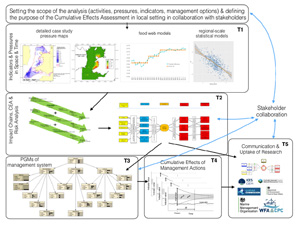Cumulative impacts and management of marine ecosystems (Module 8)
Published: 10 February 2017
 MERP has always had the ambition not only to increase scientific understanding of marine ecosystems, but also to apply this understanding to the sustainable management of our seas. In MERP Work Package 3, which started in January, this focus on the application of MERP science takes centre stage. The project that I lead seeks to understand in particular how multiple activities interact to affect marine ecosystems, and what the cumulative effects of management actions are.
MERP has always had the ambition not only to increase scientific understanding of marine ecosystems, but also to apply this understanding to the sustainable management of our seas. In MERP Work Package 3, which started in January, this focus on the application of MERP science takes centre stage. The project that I lead seeks to understand in particular how multiple activities interact to affect marine ecosystems, and what the cumulative effects of management actions are.
Our intention is to play to MERP’s existing strengths, and to this end we have assembled a team of scientists that represents much of MERP’s expertise in spatial, probabilisitc, and mechanistic modelling of marine ecosystems. We have also engaged stakeholders from the outset, both at a national level and at the regional scale of our two case studies (West Wales and South West England), so that we can work with them to co-produce outputs of real policy and management relevance.
The overall aim of the project is to show how empirical data, modelling, and expert judgement can be translated into both context-specific guidance and general principles for marine management. The substantial progress we have already made within MERP to collate existing data will be used to document spatial and temporal trends in a number of key indicators of ecosystem state, already embedded into management practices at various spatial scales. Policy drivers include the need to maintain (or return) these indicators within target ranges, but frequently, managers are required to consider multiple indicators and multiple pressures at once, and to make decisions about marginal gains - what are the cumulative effects on multiple indicators of additional management actions?
Such questions can be formalised as Cumulative Effects Assessments (CEA), and our aim in this project is to extend existing risk assessment-based CEAs to address critical and recurring evidence gaps, including issues of spatial and temporal scale (e.g. interactions between local and regional effects, expected timescales of responses to management and thus recovery potential), limited empirical data, lack of understanding of the functional form of the relationships between pressures and effects, and of how effects themselves interact, as well as the cumulative effects of management actions themselves. We believe that within the MERP scientific and stakeholder communities we have the expertise to begin to fill these gaps, using data to parameterise pressure-activity-effect chains of impacts, challenging the MERP model ensemble to provide relevant and timely outputs, and drawing on our huge collective knowledge base to better incorporate expert judgement into our Bayesian models of the case study regions.
Over the next year and a half this work will progress on a number of interrelated fronts, with formal contributions from numerous MERP partners as well as inputs from the whole community. We look forward to keeping you all up to date with our progress!